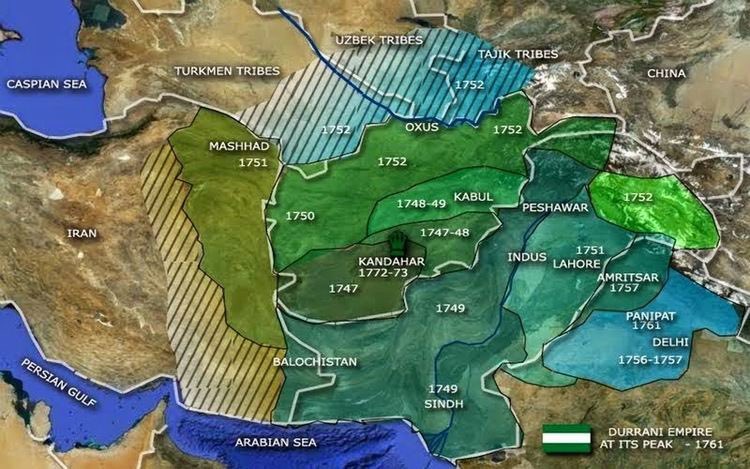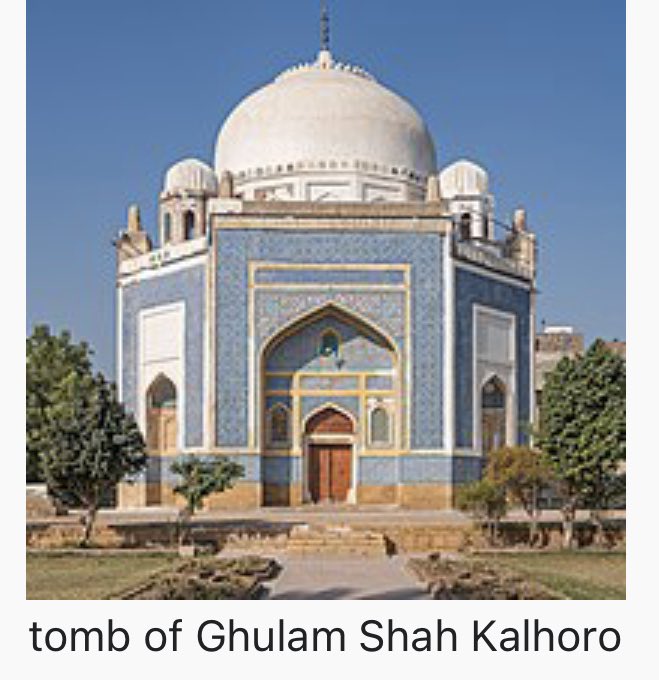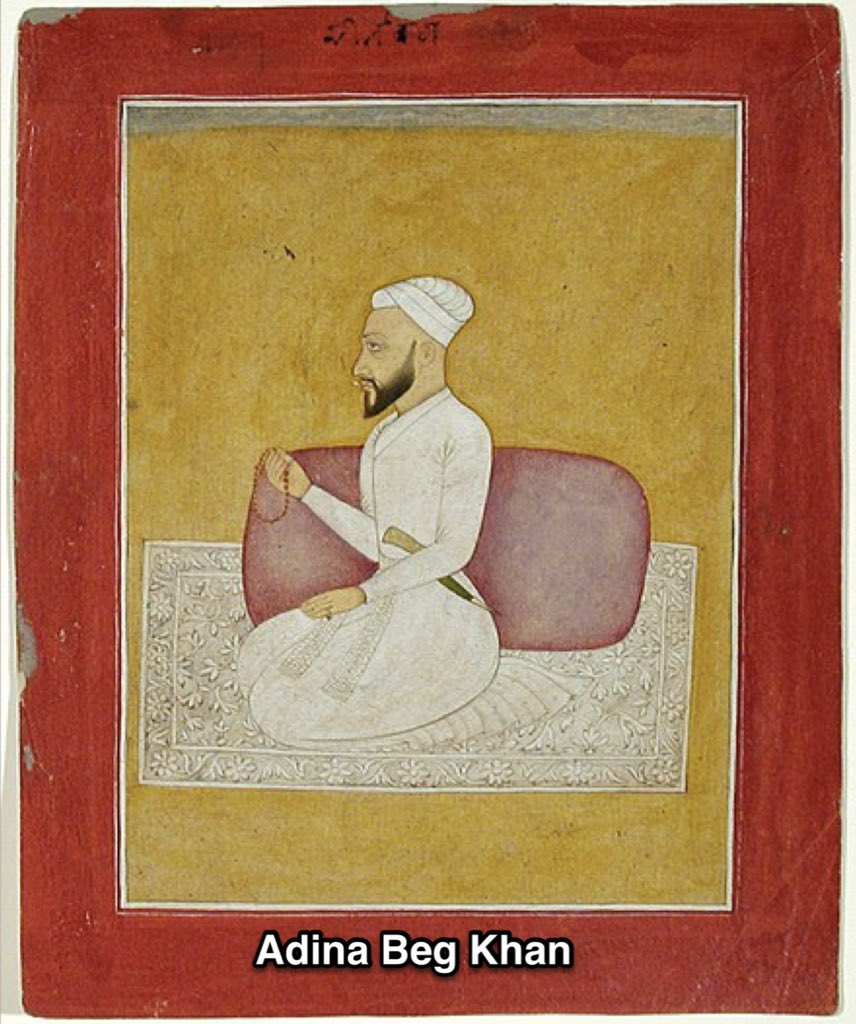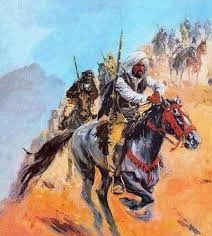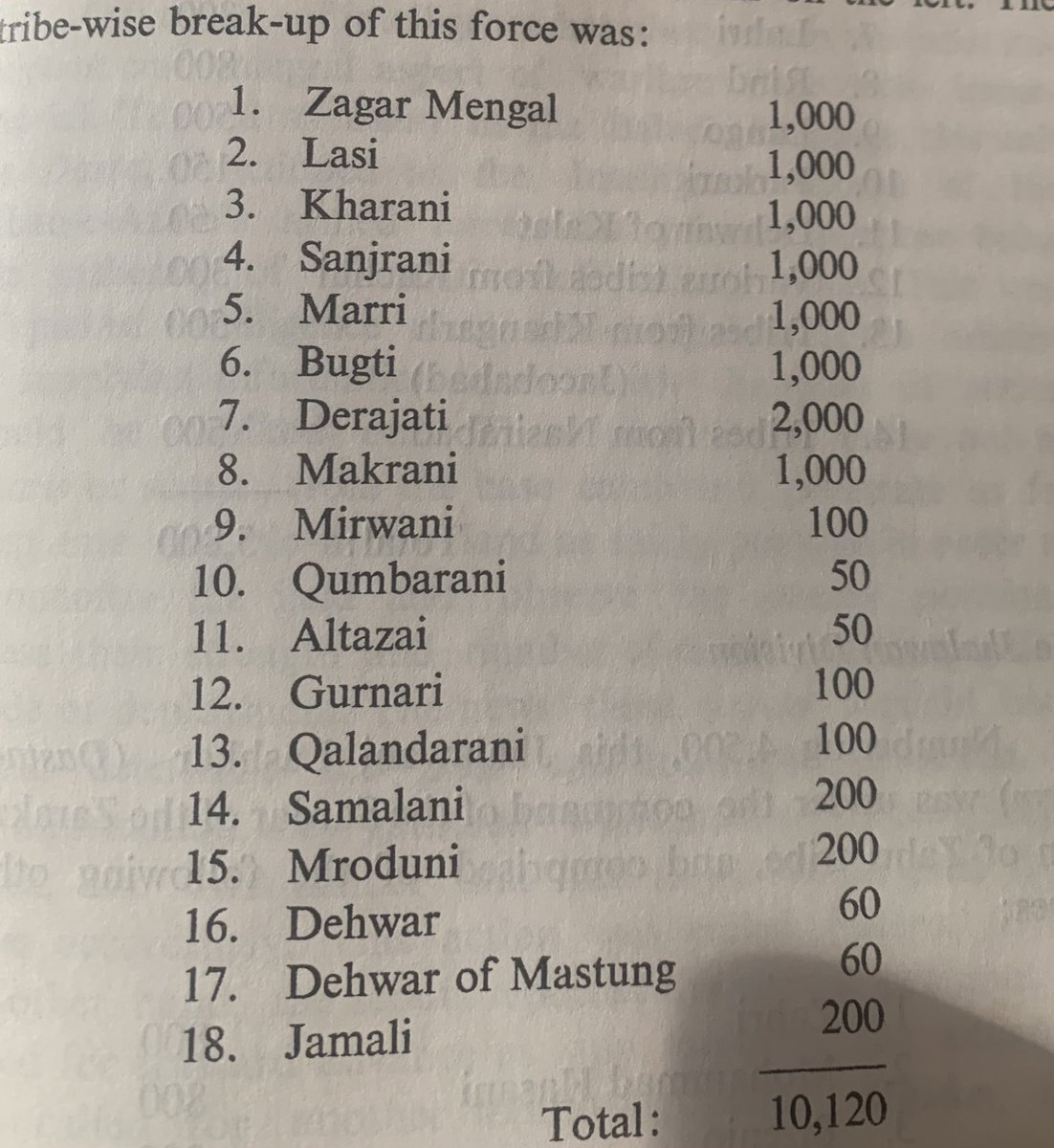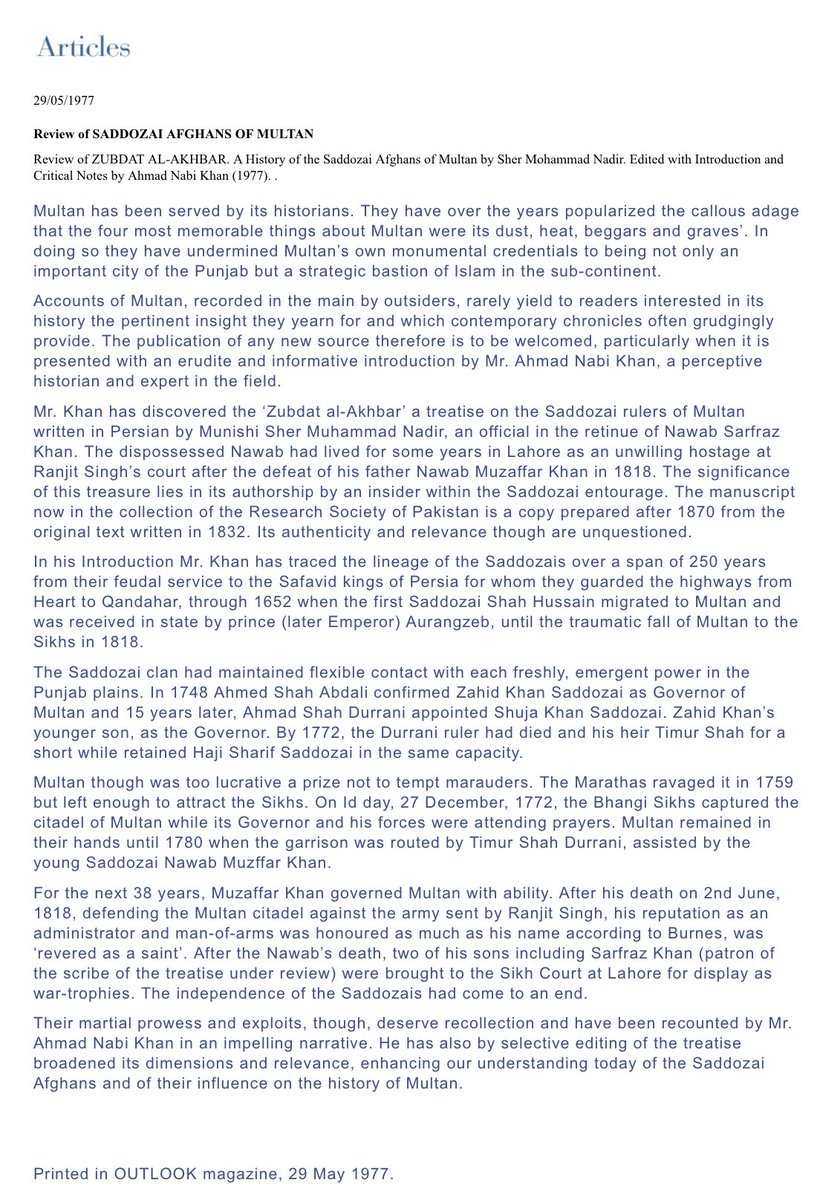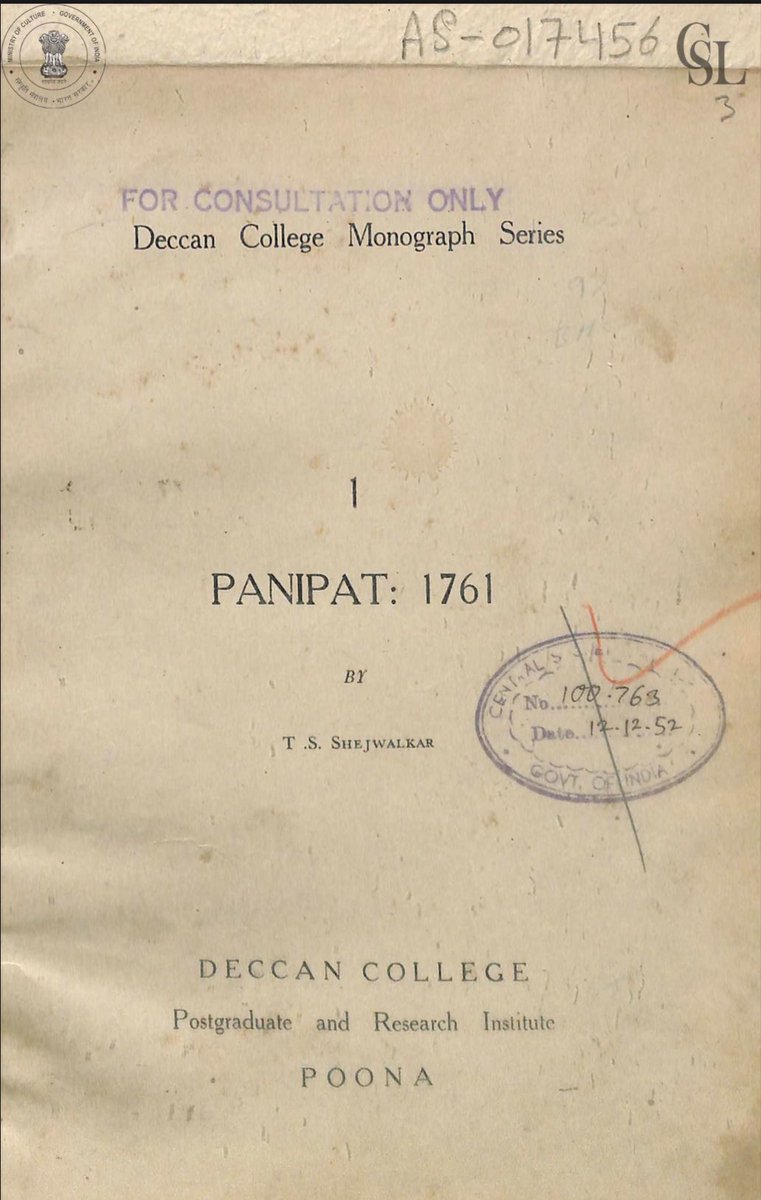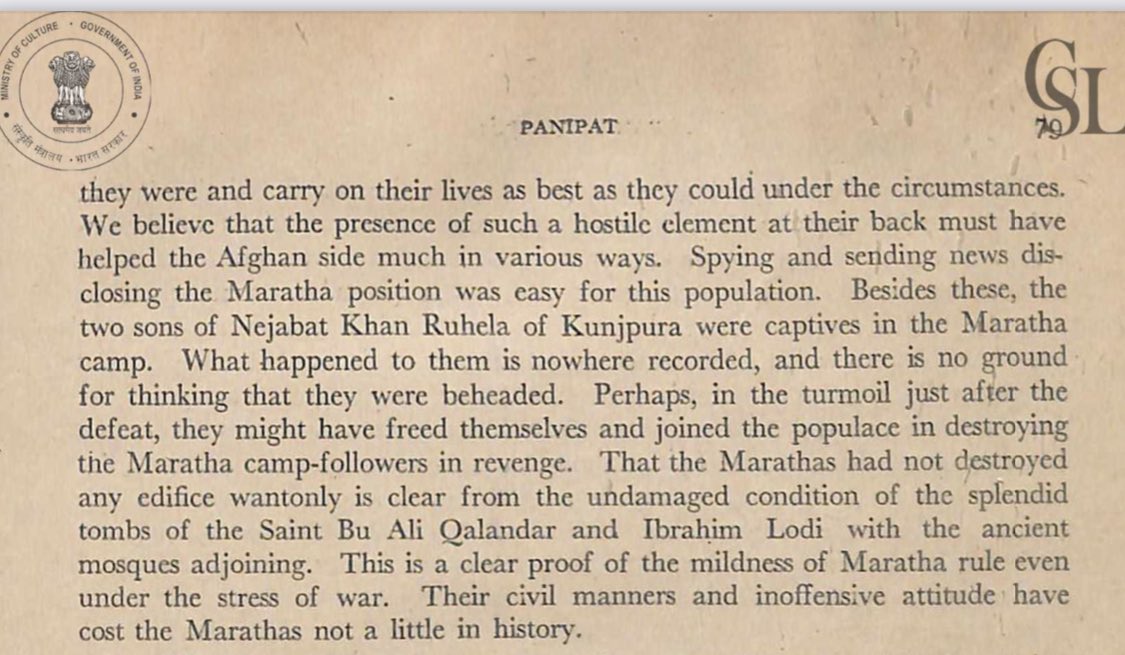On 4th January 1761, 3rd Battle of Panipat took place.
What’s often overlooked is that besides Abdali’s army from today’s Afghanistan, forces belonging to almost all major areas of today’s Pakistan participated in the battle.
From Balochistan, Sindh, Punjab, KP & Kashmir.
/1
What’s often overlooked is that besides Abdali’s army from today’s Afghanistan, forces belonging to almost all major areas of today’s Pakistan participated in the battle.
From Balochistan, Sindh, Punjab, KP & Kashmir.
/1
Kalhoros rulers of Sindh, Sadozai Pashtuns of Multan & Mughals of Kashmir ruled as governor’s of Durrani Empire by 1760s.
Mian Ghulam Shah Kalhoro sent a force to join at Panipat, defeated Marathas of Kutch himself & received title of 'Shah Wardi Khan' by Ahmed Shah Durrani.
/2
Mian Ghulam Shah Kalhoro sent a force to join at Panipat, defeated Marathas of Kutch himself & received title of 'Shah Wardi Khan' by Ahmed Shah Durrani.
/2
Adina Khan Beg, Mughal governor of Lahore had allied with Marathas to preserve his own fiefdom as Dehli’s Mughal Court became hostage to Maratha influence.
However he died before the battle of Panipat & his Muslim forces defected to Abdalis rather than fight for Marathas.
/3
However he died before the battle of Panipat & his Muslim forces defected to Abdalis rather than fight for Marathas.
/3
The historical fact is that 20,000 warriors commanded by Khane Kalat Mir Nuri Naseer Khan Ahmedzai, contingent of Sindhi warriors of Mir Ghulam Shah Kalhoro, Pashtun tribes from Pakistan, muslims from Punjab & forces from Kashmir fought alongside Abdali to defeat the Marathas
/4
/4
“Agreement of Kalat (1758) provided that henceforth Baloch forces, under the command of Khane Baloch would have their share in all future conquests of Ahmed Shah Abdali..
Consequently, Mir Naseer Khan & the army of Baluches participated with Abdali in several expeditions..”
/5
Consequently, Mir Naseer Khan & the army of Baluches participated with Abdali in several expeditions..”
/5
“.. and in some battles, Naseer Khan was himself in command of the joint forces.
His bold & victorious steering of the Battle of Meshed against the Persians, in particular, so impressed the Afghan King that the later gave him the title of Brathare Wafadar (Loyal Brother)..”
/6
His bold & victorious steering of the Battle of Meshed against the Persians, in particular, so impressed the Afghan King that the later gave him the title of Brathare Wafadar (Loyal Brother)..”
/6
“..& made a present of Shal region (now Quetta) to his mother, Bibi Maryam.
Similarly, it was Mir Naseer Khan again who, with his army of 25,000 Baluches, came to help Ahmed Shah Abdali at the famous Third Battle of Panipat in 1761. It was this combination of outstanding..”
/7
Similarly, it was Mir Naseer Khan again who, with his army of 25,000 Baluches, came to help Ahmed Shah Abdali at the famous Third Battle of Panipat in 1761. It was this combination of outstanding..”
/7
“..military valor & fighting skill which crushed once for all the rising Marhatta menace in Northern India..after 3rd Battle of Panipat in 1761.. (Sikhs) once again resumed their infiltration deeper (into Punjab), finally capturing Lahore in 1764, where they established..”
/8
/8
“..their short lived (first) Khalsa State extending from Jhelum to the banks of Jamuna...
They rose against the Muslims, whose condition was getting progressively weaker due to the onset of the general decline of the Mughal Empire. Sensing the danger to the cause of Islam..”
/9
They rose against the Muslims, whose condition was getting progressively weaker due to the onset of the general decline of the Mughal Empire. Sensing the danger to the cause of Islam..”
/9
“..Shah Waliullah of Dehli wrote to Ahmed Shah Abdali & Mir Naseer Khan, asking them help their brethren-in-faith.
This was an open call for Jehad. Abdali & Khane Baluch Mir Naseer Khan responded readily to it, latter’s contribution being a contingent of 12000 warriors..”
/10
This was an open call for Jehad. Abdali & Khane Baluch Mir Naseer Khan responded readily to it, latter’s contribution being a contingent of 12000 warriors..”
/10
“..headed by himself in front.
Thus it was that a combined army of Afghans & Baluches (Sindhis, Punjabis, Kashmiris) marched into India to meet their common foe in 1765..
And, it so happened that while Mir Naseer Khan was piercing his way on his horse through Sikh ranks..”
/11
Thus it was that a combined army of Afghans & Baluches (Sindhis, Punjabis, Kashmiris) marched into India to meet their common foe in 1765..
And, it so happened that while Mir Naseer Khan was piercing his way on his horse through Sikh ranks..”
/11
“..in a furious outburst near Lahore he fell off his steed; and as he fell to the ground, the turban he was wearing got loose.
As a result, his long hair popped out from beneath his headwear. One of the Sikh combatants noticing the fall, rushed out at him with the sword..”
/12
As a result, his long hair popped out from beneath his headwear. One of the Sikh combatants noticing the fall, rushed out at him with the sword..”
/12
“..to secure what could have been his ‘prize kill.’ But as fate would have it, another Sikh hastily halted his comrade’s blow in the nick of time, saying that the man (Naseer Khan) was a Khalsa(Sikh)!
The Sikh had naturally mistaken the turbanless Naseer Khan for a Sikh!..”
/13
The Sikh had naturally mistaken the turbanless Naseer Khan for a Sikh!..”
/13
“..However, by the time the Sikhs became aware their self-deception, Naseer Khan was once again on his feet; and other Baluch swordsmen, too, charged & drove back the Sikhs, who eventually suffered a crushing defeat & retreated in haste.
On returning to his camp after ..”
/14
On returning to his camp after ..”
/14
“..the encounter, Mir Naseer Khan immediately sent for a barber and got his long hair & beard cropped short..
The Baluches under their Khan had fought so gallantly & successfully against Sikhs that Ahmed Shah Abdali was delighted to express his appreciation & gratitude..”
/15
The Baluches under their Khan had fought so gallantly & successfully against Sikhs that Ahmed Shah Abdali was delighted to express his appreciation & gratitude..”
/15
“..in these words:
‘Khan! You once helped us, the Afghans, to become free from the slavery of Persians by giving them a crushing defeat: and now once again, on the battlefield of the Panjab, you have earned our gratitude for the selfless & gallant fight against the Sikhs”..
/16
‘Khan! You once helped us, the Afghans, to become free from the slavery of Persians by giving them a crushing defeat: and now once again, on the battlefield of the Panjab, you have earned our gratitude for the selfless & gallant fight against the Sikhs”..
/16
Khane Kalat’s Army was comprised of 4 divisions:
1-Dastae Darbar:
Elite Division of 1200 Royal Guards who served as professional soldiers under direct command of Khane Kalat called.
2-Dastae Khas:
Special Division 10,120 men raised at wartime under command of Khane Kalat.
/17
1-Dastae Darbar:
Elite Division of 1200 Royal Guards who served as professional soldiers under direct command of Khane Kalat called.
2-Dastae Khas:
Special Division 10,120 men raised at wartime under command of Khane Kalat.
/17
3-Dastae Doem:
Sarawan Division 5,800 men under the command of the Chief of Sarawan, the Sardar of Raisani tribe.
4-Dastae Soem.
Jhalawan Division 4,500 men under the command of Chief of Jhalawan, the Sardar of Zarakzai clan of the Zehri tribe.
/18
Sarawan Division 5,800 men under the command of the Chief of Sarawan, the Sardar of Raisani tribe.
4-Dastae Soem.
Jhalawan Division 4,500 men under the command of Chief of Jhalawan, the Sardar of Zarakzai clan of the Zehri tribe.
/18
Hence, this combined war effort of the ancestors of Baloch of Balochistan, Sindh, KP, Punjab
Sindhis of Sindh & Balochistan
Pashtuns of KP & Balochistan
&
Kashmiris in aid of Ahmed Shah Durrani helped ward off Maratha rule & delayed the brutal Sikha Shahi for many decades.
/19
Sindhis of Sindh & Balochistan
Pashtuns of KP & Balochistan
&
Kashmiris in aid of Ahmed Shah Durrani helped ward off Maratha rule & delayed the brutal Sikha Shahi for many decades.
/19
History also bears witness to Indian Muslims fighting with Abdali at Panipat:
-Sirajud Daulah Nawab of Oudh 20k men
-Najibud Dulah of Rohilkhand 12k men
-Even Muslim residents of Panipat aided Abdali by spying on & refusing supplies to Marathas while supplying Abdali’s army.
/20
-Sirajud Daulah Nawab of Oudh 20k men
-Najibud Dulah of Rohilkhand 12k men
-Even Muslim residents of Panipat aided Abdali by spying on & refusing supplies to Marathas while supplying Abdali’s army.
/20
References:
Above quotes excerpts are from:
1-Mir Ahmed Yar Khan, Inside Baluchistan: Political Autobiography of Khan-e-Azam. Royal Book Company Karachi. 1975.
Pages 83-93.
2-Syed Yaqoob Bazmi.
Muqaddama-e-Sirajul Absar, Vol 2.
Page 1127.
/21
Above quotes excerpts are from:
1-Mir Ahmed Yar Khan, Inside Baluchistan: Political Autobiography of Khan-e-Azam. Royal Book Company Karachi. 1975.
Pages 83-93.
2-Syed Yaqoob Bazmi.
Muqaddama-e-Sirajul Absar, Vol 2.
Page 1127.
/21
Jaswant Lal Mehta. Advanced Study in the History Of Modern India 1707-1813.
Review of Zubdat Al Akhbar-A history of Saddozai Afghans of Multan by Sher Mohammad Nadir. Edited with introduction and critical notes by Ahmed Nabi Khan 1977.
/22
Review of Zubdat Al Akhbar-A history of Saddozai Afghans of Multan by Sher Mohammad Nadir. Edited with introduction and critical notes by Ahmed Nabi Khan 1977.
/22
G. S. Chabra. Advanced Study in the History of Modern India 1707-1813. Vol 1- English edition. Page 34-35.
/23
/23
Naseer Dashti. The Baloch and Balochistan. Trafford Publishers. New York 2012. Page: 179, 185-186.
/24
/24
P. R. Blood, C. Baxter, N. Hatch Dupree, T. E. Gouitierre, R. S. Newell.
Afghanistan Revisited. Nova Science Publishers. New York. 2001.
/25
Afghanistan Revisited. Nova Science Publishers. New York. 2001.
/25

 Read on Twitter
Read on Twitter
